
|
Northern Ontario Plant Database 
Plant DescriptionRhytidiadelphus triquetrus (Hedw.) WarnstEn: shaggy moss, electrified cat's tail moss, big shaggy moss, rough neck moss
Hylocomiaceae (Feathermoss Family) Form: a coarse, robust feathermoss that forms dark- or bright-green to yellow-green, loosely spreading mats. The shoots have a characteristic shaggy appearance due to the spreading, triangular stem leaves. Gametophyte: stems creeping to erect, to 20 cm long; irregularly branched; branches spreading in various directions; main stems and branch stems reddish, smooth, visible through the leaves. Stem tips with a dense cluster of spreading leaves; branches tapering to the tips. Plants dioecious, with male and female reproductive structures borne on separate plants. Stem leaves 3.5-5 mm long, erect to wide-spreading, triangular, with lenghtwise folds (plicate), rounded at the base, gradually tapering to a straight, acuminate tip; margins entire to finely toothed (serrulate) above the middle. Costa prominent, double, extending 1/2 to _ the length of the leaf; alar cells barely differentiated from other leaf cells; leaf bases, at their attachment to the stem, yellow to orange. Branch leaves smaller, 1.8-3 mm long, lanceolate to ovate, plicate, with acuminate tips; branch leaves are more crowded and spreading than stem leaves. Sporophyte: reddish brown; seta 1.5-4.5 cm long, capsule 1.5-3.5 mm long, curved, horizontal. Habitat and Range Rhytidiadelphus triquetrus prefers moist, moderate to nutrient-rich boreal forest sites, but can also be found in the understory of deciduous forests and cedar swamps. This circumpolar species occurs throughout northern Ontario; it also occurs in New Zealand. Similar Species: Rhytidiadelphus triquetrus has distinctive red stems, similar to Pleurozium schreberi, but it is easily distinguished by its triangular leaves and shaggy appearance. Other species of Rhytidiadelphus are less coarse and have leaves that are curved or bent backward sharply at the middle (squarrose). Internet Images: This image of Rhytidiadelphus triquetrus, from Michael Simpson's Bryophytes of North America website, shows the shiny nature of the leaves. For pictures of the leaf detail, see this selection of Rhytidiadelphus triquetrus images from Bioimages: the Virtual Field-Guide. This link, with an image of 2 individual plants, provides a description of Rhytidiadelphus triquetrus in French. This detailed description of Rhytidiadelphus triquetrus and other Rhytidiadelphus species is from the online version of the Bryophyte Flora of North America. Back to species list |
||||||||||||||||||||||










